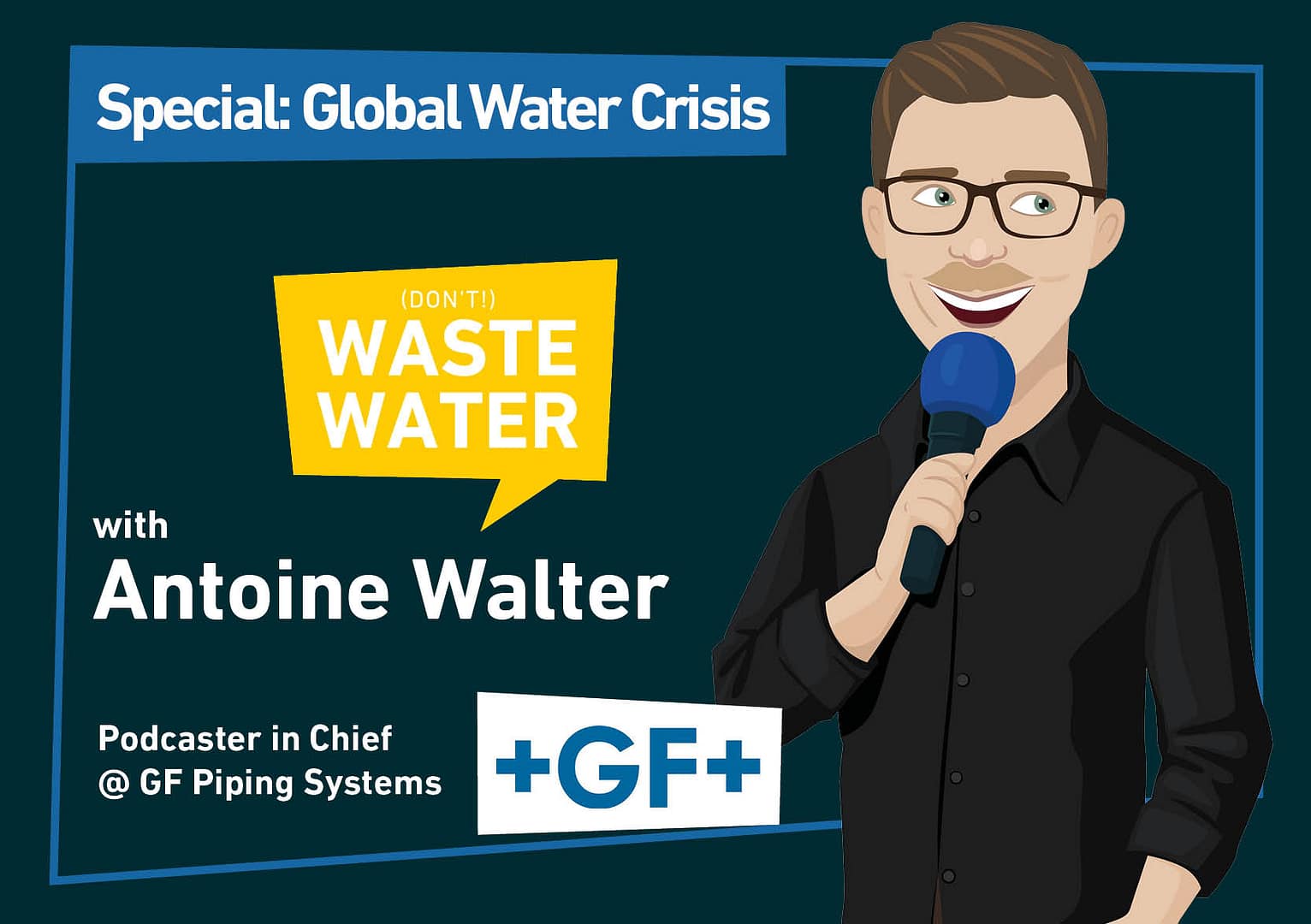Why is the world struggling to solve the water crisis when the solution seems so simple?

Humanity spends $153.2 Billion on Water every Year, yet by 2030 water demand is expected to exceed supply by 40%, 2.1 Billion people still don’t have access to safe drinking water, and just a little less than half of our wastewater is dumped to the environment untreated.

Well I’ve spent the past four years interviewing over 200 CEOs or Founders and reading far too much World Bank, OECD, UN, NGO or Academic reports to forge these two convictions: the problem is much, much worse than you think, but the solution is at hand if we put our act together.
- Why is the global water crisis more than just a shortage issue?
- How does it impact businesses around the world?
- And will we soon have to ask how close we are to a global economic collapse due to a water crisis?
Let’s dig in.
Is $153.2 Billion enough to solve the Global Water Crisis?
So I said we spend $153.2 Billion a year on Water, which may sound like a lot. But it’s just a little less than 0.2% of the World’s GDP. To put that number in context, here’s a riddle for you at home.
You know, Oil & Gas, that thing that we supposedly want to exit, which needs to be faded out, to be reduced, to be…
You get it I guess.
We’re spending 50x more on Oil & Gas than on Water
How much Public Money do you think we spend on Subsidies for Oil & Gas?
- 0, because why would you subsidize something you’d like to exit?
- 0, because when oil and gas companies post record profits, there’s no point in subsidizing them?
- 0, because you still can’t drink oil?
- 7 trillion dollars?
Can you guess? I fear you can.
Well, as crazy as it sounds, Oil & Gas subsidies indeed reached $7 Trillion in 2022 – and that’s about 50 times more than what’s spent on Water.
Do we invest enough in solving the Global Water Crisis?
But wait, 153.2 billion dollars is already a lot of money, maybe that’s enough? Well, not at all.
Just to reach the United Nation’s Sustainable Development Goal number 6 – universal access to safe drinking water, and sanitation for all – we would need to spend $140 Billion more per year. So if I take a shortcut, we would have to double the World’s spending.
Still, that’s an average. In South Saharan Africa, that means multiplying spending by up to 17 for Water, and for the Low Income Countries you can see in deep purple on the map below, that means multiplying spending by up to 42 times for wastewater.

Yet theoretically we could afford it!
The good news, is that we can afford it. According to Water.org, the annual “coping costs” of people not having access to Water and wastewater services are estimated to $300 Billion.
So if we do quick maths, we will probably prefer spending an additional $140 Billion per Year, and have everyone covered with the human right to Water and sanitation, than keep losing $300 Billion a year in evitable diseases, losses of productivity and death.
The problem is, that it’s not that straightforward.
I know, I even said it in a TED talk – bragging time!
But there’s news on that front, it comes from the latest World Bank Report on the topic, and it’s really, really, counter-intuitive, to say the least.
The Hidden Inefficiencies in Water Utilities that aggravate the Global Water Crisis
Figure that: if you speak with a water utility, almost everywhere around the World, they’ll tell you that they are underfunded, and we just saw that indeed, they are.
But meanwhile, those same water utilities don’t spend all of their money. Like, not at all.
In that report, the World Bank estimates that 28% of the sector’s allocated funds go unspent.
It’s like you need 20 bricks to build a wall, you only get 10, you only use 7 and then everybody’s surprised the wall looks weird.

Inefficiency is on the rise while productivity is down
And that’s not the end, over the last decade, water sector public spending also saw a 6% decline in productivity, the cost efficiency of projects went down to 87% and the median technical efficiency to 63%.


So, to continue with the analogy, my 7-brick wall also took longer to build as expected, is made of questionable materials, and 3 of the bricks are misaligned.
What are the consequences of Water’s Failure?
So we’re very actively failing at solving today’s water challenges, we’re progressing at one fourth of the speed needed to reach our 2030 targets, and you’ll be surprised, that’s still not the end of it.
Because yeah, what could be worse than not having enough Water for everyone to strive? Oh you’re right, we could run out of food too.
In the same structural underfunding we’re discussing so far, we’re also missing 3.5 billion dollars of yearly investment in irrigation.
All SDGs are suffering from the lack of progress in achieving SDG 6
Which totally froze the progress towards SDG 2 (zero hunger) as no region in the World lowered its hunger and unnourishment rates between 2014 and 2019, food availability per capita declined, and vulnerability to food insecurity increased.
Remember how the Food and Agriculture Organization estimates we need to raise overall food production by some 70 percent by 2050? Well, good luck with doing that without Water!
And I could continue on by telling you how this impacts SDG 1 (no poverty), SDG 3 (good health) and almost all the others, but you got my message, I guess, the Water Sector is the embodiment of this famous Chandler Bing quote in Friends:

Water Crisis: a Global Economic Threat?
Now, in “Sustainable Development Goals” there’s “Development” – so does this imply that this is essentially a developing World problem?
Well, let’s look at the World’s wealthiest countries’ infrastructure.
The US EPA regularly runs a health check on the country’s infrastructure since the 1980s. By then, they estimated that 2% of the infrastructure was in “very poor” condition. Which is concerning, because we usually replace 0.2 to 0.5% of our infrastructure every Year in the developed World. But still, 2%, that’s OK-ish, right?
Well, by 2020, the same EPA estimated that now 23% of the infrastructure was in “very poor” condition, and an additional 9% had already elapsed its lifetime.
North America lets 119 Liters per Day and Capita leak away
No wonder North America loses 119 liters per capita and per day in leaks on the water network.
Wait, it’s gonna hurt my brain, but if I’m addressing North America, I probably shall translate that, that’s 31.4 gallons of Water per person wasted everyday, or in even simpler terms, one full bathtub. Every Day!
In money terms, this means that the backlog costs to just bring back the US Infrastructure on track rose from $140.5 billion in 1995 to $345.1 billion in 2015, $473 billion in 2018 and $630 billion in the latest EPA study published last week!

Well, I wouldn’t be a wiseass, if I were you, Europe. I picked on the US because it was the latest off the press, but the situation is not much different in Europe, just a tad more scattered.
So. What’s the way forward?
It’s time to change if we want to solve the Global Water Crisis
I believe that what we’re learning here is that: same old, same old won’t work. The public sector is not ready to throw more money at the problem, or at least not to the extent needed, and even if it were, we’ve seen that the existing players would struggle to absorb that money, so that there would be tremendous efficiency losses between investment and actual action.
But the good news is, that another path is possible.
From Crisis to $12.6 Trillion Opportunity
86 trillion dollars a year of economic activities depend on Water to keep existing, let alone striving.

And these companies will not let their businesses fade out, just because the water sector can’t put its act together. So, they’ve started investing in mitigating their water risk, and they will continue to do so.
If we need proof of that, we can look at CDP’s yearly water report as they survey companies to disclose and report their water risk and progresses towards water security. I did that in great detail, if you’re interested and you missed it have a look below:
Water disclosure and Business Involvement is on the Rise
But in a nutshell, over the last 5 years, disclosure rose by 85%, bringing the global investment opportunity from valuing Water to 2.3 trillion dollars.
CDP looks every Year in the mirror, so their numbers are pretty down to earth. But if we look on the horizon, Global Water Intelligence did the exercise to project what will happen in 2034, and their result speaks for itself: they expect that opportunity to rise to 12.6 trillion dollars.
So yes, we’re failing in Water so far. But if we assume that the obstacle is the way, we’re not doomed to keep failing, as there are solutions at hand.
And if we put our act together, what we call “failure” today will swiftly become “backlog” which, in turn, will represent a tremendous investment and business opportunity.
There is an Opportunity in the Global Water Crisis!
So let me conclude with this simple projection: the total value of water solutions and technology companies is projected to grow from $290 Billion in 2024 to $1.4 Trillion in 2034. That’s a 17% CAGR.
So, if you want to make money while helping those incredible entrepreneurs to do good, you’ll want to subscribe to stay up to date, and I’ll see you next time!

